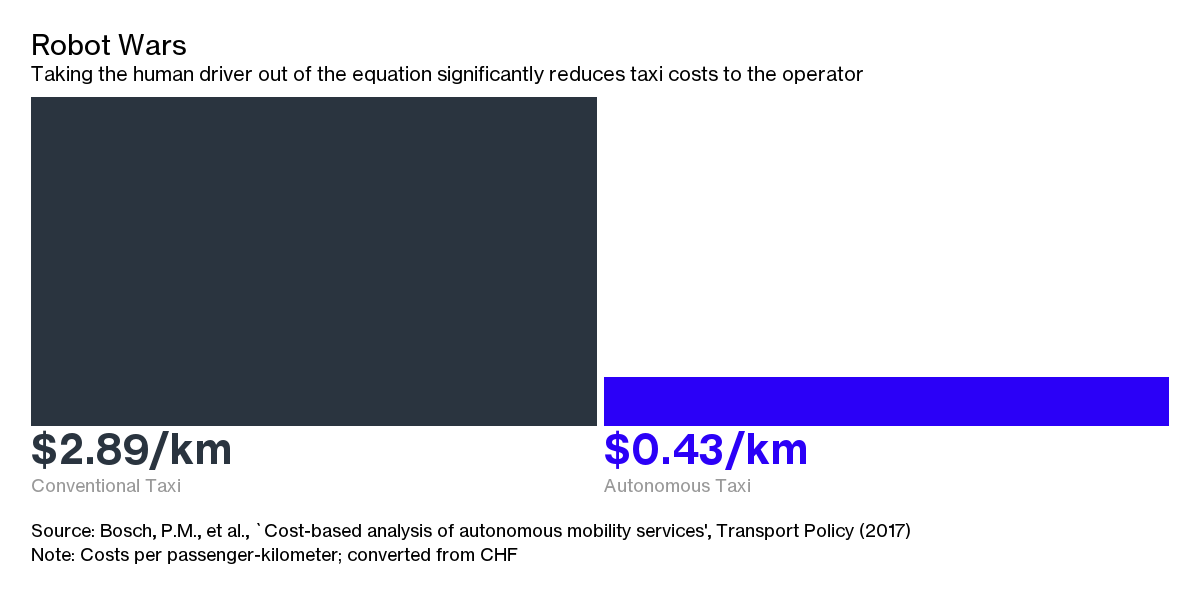Last week, Uber Technologies Inc. suspended its self-driving car program after a test vehicle killed a pedestrian in Arizona.
There’s an investigation into the accident. But even without the safety risks and ethical conundrums posed by autonomous cars, there are sound business reasons why Uber should fully abandon plans to develop or buy its own fleets of self-driving vehicles.
It’s long been a tenet of Uber believers that autonomous cars are essential to the business model. At present, Uber’s cut is about a quarter of the driver’s total fare. Eliminate the driver and replace him or her with an Uber-owned robo-taxi, runs the logic, and net revenue will soar.
Robot Wars
Taking the human driver out of the equation significantly reduces taxi costs to the operator
Source: Bosch, P.M., et al., `Cost-based analysis of autonomous mobility services’, Transport Policy (2017)

But that doesn’t exactly fit with the asset-light nirvana pursued by most Silicon Valley pioneers. Uber and its peers would have to spend a staggering sum of money if they wanted their own self-driving fleets on the road.
Boston Consulting Group estimates that an average electric-drive autonomous car will cost about $34,000 by 2030. To get the economies of scale to make autonomous ride-sharing as profitable as possible, it adds, the U.S. alone would need nine million such vehicles on its roads. That outlay would equate to $306 billion for the ride-hailing companies.
This is obviously a very rough calculation done to illustrate a point (maybe Uber could do it cheaper if it developed its own cars or wrote some great software it could sell to others). But say it secured a 50 percent market share, then the cost of the needed vehicles could be about $150 billion.
Even if you spread that over 10 years as you’re building the fleet, that’s a monumental outlay for a company already struggling with deep losses—some $4.5 billion last year on sales of $7.5 billion.
Probably not the kind of thing new CEO Dara Khosrowshahi would want to wave in front of investors as he targets an initial public offering next year.
Why Own a Car?
Classic car rental companies’ healthy operating profits are dragged down by the costs of car ownership
Source: Bloomberg

So why bother? Uber has established a remarkable brand and dominance in many markets by keeping things as stripped down as possible, including its determined resistance to treating drivers as employees. Why would it want the hassle of owning, maintaining and upgrading a fleet?
Companies with far deeper pockets (not only Alphabet Inc. and Apple Inc., but carmakers such as General Motors Co. and Daimler AG) are ploughing billions of dollars into autonomous car projects. Yet by the time the technology is prevalent, it will be a commodity.
Khosrowshahi should instead spend Uber’s precious dollars on securing market share in North America and Europe. It can be the marketplace that connects fleets of autonomous cars with passengers, in the same way as it connects drivers today.
Ownership and operation of robo-taxi fleets could be left to carmakers, rental companies such as Hertz Global Holdings Inc. or Avis Budget Group Inc., or any other enterprising business people. Another advantage is that incumbent carmakers needn’t necessarily lose out. Uber could still enjoy better profits (or profit, at least), but without the burden of costly assets.
Khosrowshahi should slam the brakes on Uber’s robo-taxi venture.
This column does not necessarily reflect the opinion of Bloomberg LP and its owners.
